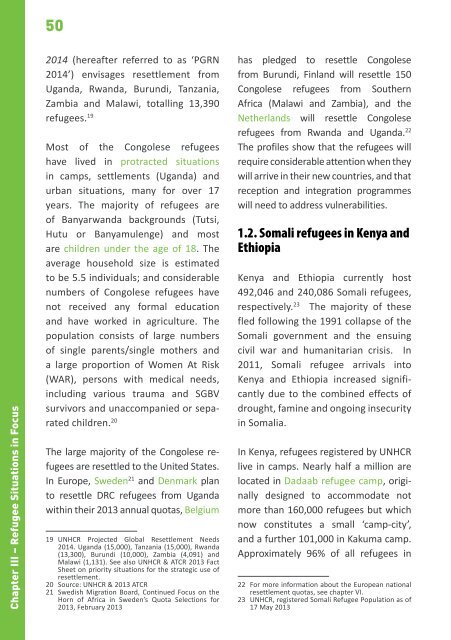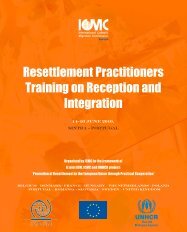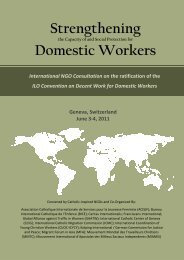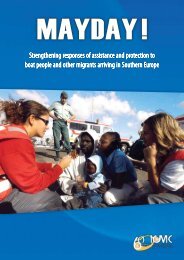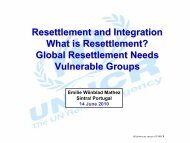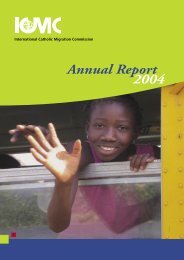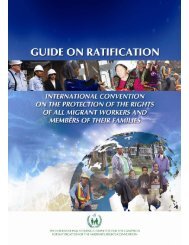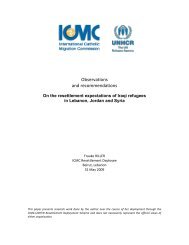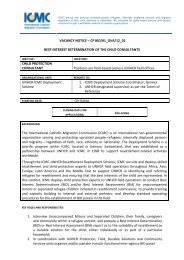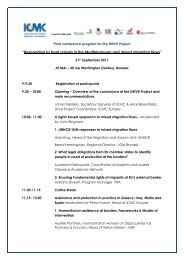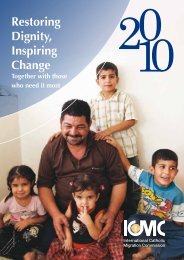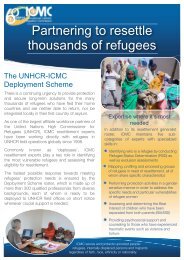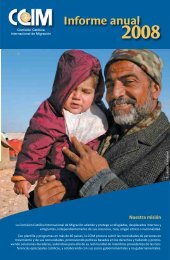ICMCEUROPE WelcometoEurope.pdf (5.89 MB)
ICMCEUROPE WelcometoEurope.pdf (5.89 MB)
ICMCEUROPE WelcometoEurope.pdf (5.89 MB)
Create successful ePaper yourself
Turn your PDF publications into a flip-book with our unique Google optimized e-Paper software.
50<br />
Chapter III – Refugee Situations in Focus<br />
2014 (hereafter referred to as ‘PGRN<br />
2014’) envisages resettlement from<br />
Uganda, Rwanda, Burundi, Tanzania,<br />
Zambia and Malawi, totalling 13,390<br />
refugees. 19<br />
Most of the Congolese refugees<br />
have lived in protracted situations<br />
in camps, settlements (Uganda) and<br />
urban situations, many for over 17<br />
years. The majority of refugees are<br />
of Banyarwanda backgrounds (Tutsi,<br />
Hutu or Banyamulenge) and most<br />
are children under the age of 18. The<br />
average household size is estimated<br />
to be 5.5 individuals; and considerable<br />
numbers of Congolese refugees have<br />
not received any formal education<br />
and have worked in agriculture. The<br />
population consists of large numbers<br />
of single parents/single mothers and<br />
a large proportion of Women At Risk<br />
(WAR), persons with medical needs,<br />
including various trauma and SGBV<br />
survivors and unaccompanied or separated<br />
children. 20<br />
The large majority of the Congolese refugees<br />
are resettled to the United States.<br />
In Europe, Sweden 21 and Denmark plan<br />
to resettle DRC refugees from Uganda<br />
within their 2013 annual quotas, Belgium<br />
19 UNHCR Projected Global Resettlement Needs<br />
2014. Uganda (15,000), Tanzania (15,000), Rwanda<br />
(13,300), Burundi (10,000), Zambia (4,091) and<br />
Malawi (1,131). See also UNHCR & ATCR 2013 Fact<br />
Sheet on priority situations for the strategic use of<br />
resettlement.<br />
20 Source: UNHCR & 2013 ATCR<br />
21 Swedish Migration Board, Continued Focus on the<br />
Horn of Africa in Sweden’s Quota Selections for<br />
2013, February 2013<br />
has pledged to resettle Congolese<br />
from Burundi, Finland will resettle 150<br />
Congolese refugees from Southern<br />
Africa (Malawi and Zambia), and the<br />
Netherlands will resettle Congolese<br />
refugees from Rwanda and Uganda. 22<br />
The profiles show that the refugees will<br />
require considerable attention when they<br />
will arrive in their new countries, and that<br />
reception and integration programmes<br />
will need to address vulnerabilities.<br />
1.2. Somali refugees in Kenya and<br />
Ethiopia<br />
Kenya and Ethiopia currently host<br />
492,046 and 240,086 Somali refugees,<br />
respectively. 23 The majority of these<br />
fled following the 1991 collapse of the<br />
Somali government and the ensuing<br />
civil war and humanitarian crisis. In<br />
2011, Somali refugee arrivals into<br />
Kenya and Ethiopia increased significantly<br />
due to the combined effects of<br />
drought, famine and ongoing insecurity<br />
in Somalia.<br />
In Kenya, refugees registered by UNHCR<br />
live in camps. Nearly half a million are<br />
located in Dadaab refugee camp, originally<br />
designed to accommodate not<br />
more than 160,000 refugees but which<br />
now constitutes a small ‘camp-city’,<br />
and a further 101,000 in Kakuma camp.<br />
Approximately 96% of all refugees in<br />
22 For more information about the European national<br />
resettlement quotas, see chapter VI.<br />
23 UNHCR, registered Somali Refugee Population as of<br />
17 May 2013


